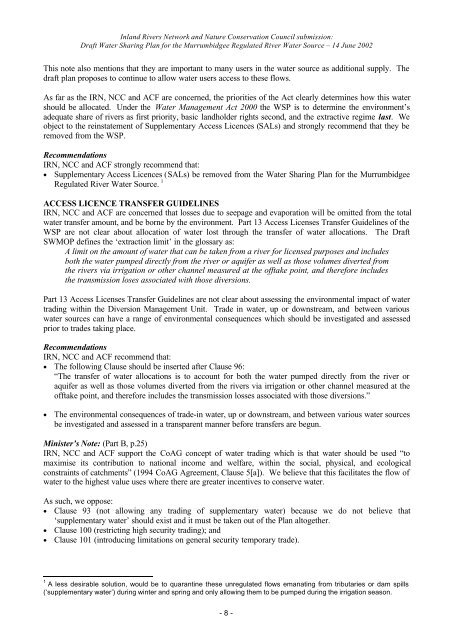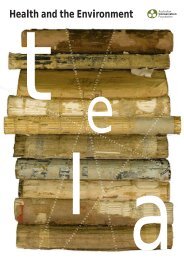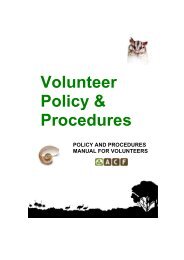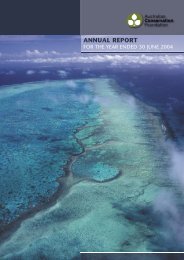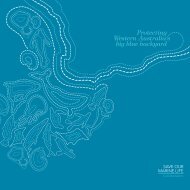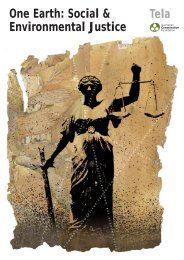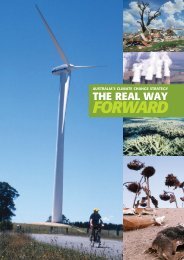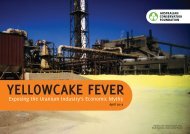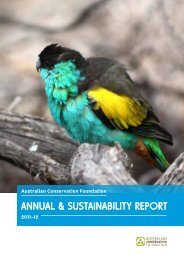Submission on Draft Water Sharing Plan for the Murrumbidgee River
Submission on Draft Water Sharing Plan for the Murrumbidgee River
Submission on Draft Water Sharing Plan for the Murrumbidgee River
You also want an ePaper? Increase the reach of your titles
YUMPU automatically turns print PDFs into web optimized ePapers that Google loves.
Inland <strong>River</strong>s Network and Nature C<strong>on</strong>servati<strong>on</strong> Council submissi<strong>on</strong>:<br />
<strong>Draft</strong> <strong>Water</strong> <strong>Sharing</strong> <strong>Plan</strong> <strong>for</strong> <strong>the</strong> <strong>Murrumbidgee</strong> Regulated <strong>River</strong> <strong>Water</strong> Source – 14 June 2002<br />
This note also menti<strong>on</strong>s that <strong>the</strong>y are important to many users in <strong>the</strong> water source as additi<strong>on</strong>al supply. The<br />
draft plan proposes to c<strong>on</strong>tinue to allow water users access to <strong>the</strong>se flows.<br />
As far as <strong>the</strong> IRN, NCC and ACF are c<strong>on</strong>cerned, <strong>the</strong> priorities of <strong>the</strong> Act clearly determines how this water<br />
should be allocated. Under <strong>the</strong> <strong>Water</strong> Management Act 2000 <strong>the</strong> WSP is to determine <strong>the</strong> envir<strong>on</strong>ment’s<br />
adequate share of rivers as first priority, basic landholder rights sec<strong>on</strong>d, and <strong>the</strong> extractive regime last. We<br />
object to <strong>the</strong> reinstatement of Supplementary Access Licences (SALs) and str<strong>on</strong>gly recommend that <strong>the</strong>y be<br />
removed from <strong>the</strong> WSP.<br />
Recommendati<strong>on</strong>s<br />
IRN, NCC and ACF str<strong>on</strong>gly recommend that:<br />
• Supplementary Access Licences (SALs) be removed from <strong>the</strong> <strong>Water</strong> <strong>Sharing</strong> <strong>Plan</strong> <strong>for</strong> <strong>the</strong> <strong>Murrumbidgee</strong><br />
Regulated <strong>River</strong> <strong>Water</strong> Source. 1<br />
ACCESS LICENCE TRANSFER GUIDELINES<br />
IRN, NCC and ACF are c<strong>on</strong>cerned that losses due to seepage and evaporati<strong>on</strong> will be omitted from <strong>the</strong> total<br />
water transfer amount, and be borne by <strong>the</strong> envir<strong>on</strong>ment. Part 13 Access Licenses Transfer Guidelines of <strong>the</strong><br />
WSP are not clear about allocati<strong>on</strong> of water lost through <strong>the</strong> transfer of water allocati<strong>on</strong>s. The <strong>Draft</strong><br />
SWMOP defines <strong>the</strong> ‘extracti<strong>on</strong> limit’ in <strong>the</strong> glossary as:<br />
A limit <strong>on</strong> <strong>the</strong> amount of water that can be taken from a river <strong>for</strong> licensed purposes and includes<br />
both <strong>the</strong> water pumped directly from <strong>the</strong> river or aquifer as well as those volumes diverted from<br />
<strong>the</strong> rivers via irrigati<strong>on</strong> or o<strong>the</strong>r channel measured at <strong>the</strong> offtake point, and <strong>the</strong>re<strong>for</strong>e includes<br />
<strong>the</strong> transmissi<strong>on</strong> loses associated with those diversi<strong>on</strong>s.<br />
Part 13 Access Licenses Transfer Guidelines are not clear about assessing <strong>the</strong> envir<strong>on</strong>mental impact of water<br />
trading within <strong>the</strong> Diversi<strong>on</strong> Management Unit. Trade in water, up or downstream, and between various<br />
water sources can have a range of envir<strong>on</strong>mental c<strong>on</strong>sequences which should be investigated and assessed<br />
prior to trades taking place.<br />
Recommendati<strong>on</strong>s<br />
IRN, NCC and ACF recommend that:<br />
• The following Clause should be inserted after Clause 96:<br />
“The transfer of water allocati<strong>on</strong>s is to account <strong>for</strong> both <strong>the</strong> water pumped directly from <strong>the</strong> river or<br />
aquifer as well as those volumes diverted from <strong>the</strong> rivers via irrigati<strong>on</strong> or o<strong>the</strong>r channel measured at <strong>the</strong><br />
offtake point, and <strong>the</strong>re<strong>for</strong>e includes <strong>the</strong> transmissi<strong>on</strong> losses associated with those diversi<strong>on</strong>s.”<br />
• The envir<strong>on</strong>mental c<strong>on</strong>sequences of trade-in water, up or downstream, and between various water sources<br />
be investigated and assessed in a transparent manner be<strong>for</strong>e transfers are begun.<br />
Minister’s Note: (Part B, p.25)<br />
IRN, NCC and ACF support <strong>the</strong> CoAG c<strong>on</strong>cept of water trading which is that water should be used “to<br />
maximise its c<strong>on</strong>tributi<strong>on</strong> to nati<strong>on</strong>al income and welfare, within <strong>the</strong> social, physical, and ecological<br />
c<strong>on</strong>straints of catchments” (1994 CoAG Agreement, Clause 5[a]). We believe that this facilitates <strong>the</strong> flow of<br />
water to <strong>the</strong> highest value uses where <strong>the</strong>re are greater incentives to c<strong>on</strong>serve water.<br />
As such, we oppose:<br />
• Clause 93 (not allowing any trading of supplementary water) because we do not believe that<br />
‘supplementary water’ should exist and it must be taken out of <strong>the</strong> <strong>Plan</strong> altoge<strong>the</strong>r.<br />
• Clause 100 (restricting high security trading); and<br />
• Clause 101 (introducing limitati<strong>on</strong>s <strong>on</strong> general security temporary trade).<br />
1 A less desirable soluti<strong>on</strong>, would be to quarantine <strong>the</strong>se unregulated flows emanating from tributaries or dam spills<br />
(‘supplementary water’) during winter and spring and <strong>on</strong>ly allowing <strong>the</strong>m to be pumped during <strong>the</strong> irrigati<strong>on</strong> seas<strong>on</strong>.<br />
- 8 -


